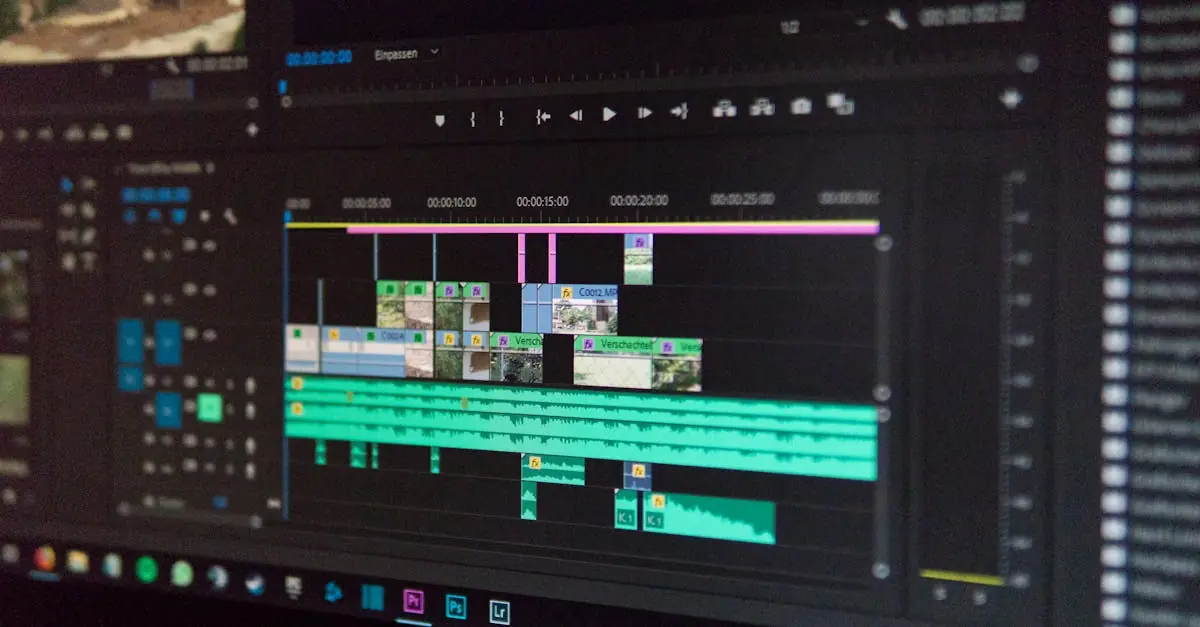In the vibrant world of digital graphic design, having the right tools is like a chef having the perfect knives—essential for whipping up stunning creations. Whether it’s crafting eye-popping logos or designing sleek websites, the tools a designer uses can make or break their artistic vision. But with so many options out there, it’s easy to feel like a kid in a candy store, overwhelmed by choices.
Table of Contents
ToggleOverview of Digital Graphic Design Tools
Digital graphic design relies on various tools that enhance creativity and efficiency. Designers use software programs like Adobe Photoshop, Adobe Illustrator, and CorelDRAW to create visually appealing images and graphics. Each program serves specific purposes. For instance, Photoshop excels at image editing, while Illustrator is preferred for vector graphics and illustrations.
Additionally, there are online design platforms such as Canva and Figma. Canva provides user-friendly templates that cater to non-designers and professionals alike, simplifying the creation process. Figma, on the other hand, facilitates collaboration among teams, making it ideal for web and interface design.
Hardware plays a crucial role as well. Digital tablets and styluses enable artists to draw with precision, simulating traditional sketching techniques. Graphic designers also benefit from powerful computers equipped with high-resolution monitors. These devices enhance the design experience by displaying intricate details and vibrant colors.
Furthermore, plugins and extensions enhance base software functionality. Tools like Filter Forge and Nik Collection add advanced effects and filters to images, expanding design possibilities. Color palette generators, such as Coolors and Adobe Color, help designers select harmonious color schemes effectively.
As technology evolves, newer tools continue to emerge, meeting the changing demands of the industry. Designers must stay updated on the latest tools and trends to maintain a competitive edge. The choice of tools ultimately shapes the quality and impact of graphic design projects, underscoring their importance in the creative process.
Graphic Design Software
Digital graphic design relies heavily on software tools that streamline the creative process and enhance the quality of work produced. Various programs serve distinct purposes, allowing designers to choose tools tailored to their specific needs.
Adobe Creative Suite
Adobe Creative Suite stands as a cornerstone in graphic design. This suite includes Adobe Photoshop, which excels at photo editing, and Adobe Illustrator, known for vector graphic creation. Additionally, Adobe InDesign supports layout design for print and digital publications. Designers find the integration between these applications invaluable. They can easily transfer assets, maintain consistency across projects, and utilize shared libraries for efficiency. Many industry professionals regard Adobe Creative Suite as a must-have due to its comprehensive features and robust support community.
Alternatives to Adobe
Alternatives to Adobe exist for designers seeking flexibility or lower costs. Affinity Designer and Affinity Photo offer features comparable to Adobe’s offerings at a one-time purchase fee. CorelDRAW also remains a popular choice for vector illustrations. Moreover, online platforms like Canva give users access to templates and design tools without a steep learning curve. Figma facilitates collaborative web and interface design, allowing real-time feedback among team members. These alternatives enable designers to explore diverse tools while maintaining high-quality outputs, catering to varying project requirements.
Online Design Platforms
Designers leverage online design platforms to streamline their workflow and enhance creativity. These tools simplify complex design tasks and allow for easy collaboration.
Canva
Canva stands out for its user-friendly interface, catering to both novices and seasoned designers. The platform offers thousands of templates suitable for various projects, including social media graphics, posters, and presentations. Users can customize designs by selecting from a rich library of images, fonts, and icons. Collaboration is straightforward; team members can share and edit designs in real time, making it ideal for group projects. Canva Pro enhances functionality with advanced features like brand kits and animation options, ensuring professional quality across all outputs.
Figma
Figma serves as a robust tool specifically designed for interface design and prototyping. Its browser-based platform facilitates real-time collaboration, allowing teams to work simultaneously on projects. Designers benefit from Figma’s vector graphics and prototyping features, which create interactive designs with ease. Components and styles streamline the design process, ensuring consistency across multiple screens. Integration with other tools enables seamless workflows, further enhancing productivity. Figma’s community offers resources like templates and plugins, empowering users to elevate their design projects efficiently.
3D Design Tools
3D design tools play a vital role in creating realistic visuals and dynamic animations. Designers use these applications to bring ideas to life in three dimensions.
Blender
Blender serves as a powerful open-source 3D design tool, offering extensive modeling and animation features. With its comprehensive suite, designers can create intricate 3D models, realistic animations, and even engage in game design. It’s suitable for both beginners and experienced users due to its user-friendly interface and rich community support. Blender supports features like sculpting, texturing, and rendering, which enhance its versatility. Many designers appreciate its ability to produce high-quality outputs without costly software fees. Resources like tutorials and forums contribute to a thriving user community, allowing designers to learn and share their expertise.
Cinema 4D
Cinema 4D is known for its robust capabilities in motion graphics and 3D design. Designers find its intuitive interface facilitates a smooth workflow, enabling quick project execution. This software excels in creating complex animations and realistic visual effects, making it popular among professionals in advertising and film industries. Unique features like MoGraph enable designers to generate dynamic motion graphics with ease. Additionally, Cinema 4D integrates seamlessly with other software, such as Adobe After Effects, enhancing creative possibilities. The software’s regular updates ensure that it incorporates the latest design trends and technologies, keeping designers at the forefront of innovation.
The right tools in digital graphic design can transform a designer’s creative journey. With a mix of powerful software and innovative online platforms, designers can elevate their projects to new heights. From Adobe’s industry-standard applications to user-friendly options like Canva and Figma, the choices available cater to various skill levels and project needs.
Incorporating advanced hardware and plugins further enhances the design process, allowing for greater efficiency and creativity. As the digital landscape continues to evolve, staying informed about emerging tools and trends is crucial for maintaining a competitive edge. Ultimately, the tools a designer selects can significantly influence the quality and impact of their work, shaping the future of their artistic endeavors.




